How to be a modern machine
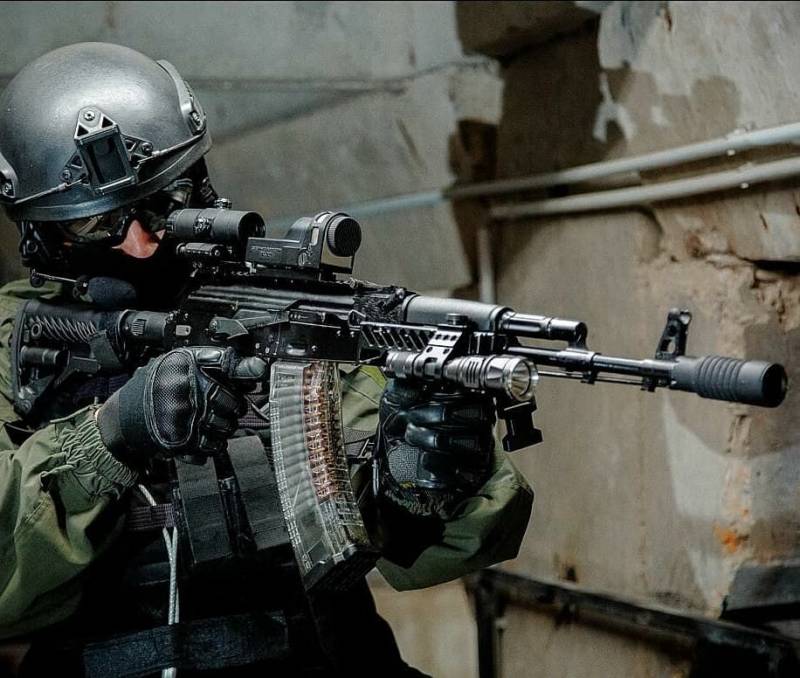
Translator's note. Translation of the article Braut der Soldaten ("The Soldier's Bride" is a slang term for rifles given by German soldiers, something like "our wives are guns loaded"), published in the German gun magazine Deutsche Waffenjournal N4-2022. This article continues what was started by the German weapons magazine" a series of materials on the future of small arms, opened with an essay "Firepower in hand. What to be a modern machine gun».
Author: Franz Keck.
Translation: Slug_BDMP.
The scandal associated with the G36 assault rifle, the protracted search for its successor, the American NGSW program again highlighted the topic of the assault rifle / assault rifle - a generalized individual weapon of a soldier. DWJ took the liberty of expressing his opinion on this subject.
A rifle (automatic) is the personal weapon of every soldier that accompanies him in war and exercises 24 hours a day and 7 days a week. A kind of personal attachment develops between the soldier and the rifle. This is especially true for infantrymen and military personnel of related branches of the armed forces. The nickname "soldier's bride", developed by the American Major General Rupertus during the Second World War, the American Marine Corps' Gunner's Creed, or the names that soldiers give to their weapons, is the best proof of this. This attitude persists to this day, although not in such a formalized form. Rifles now do not go through the rite of "baptism", and the "Archer's Creed" is no longer memorized.
Since at least the First World War, small arms and the skills of ordinary shooters have not been decisive for the outcome of the war. In the conflict of states, as the events unfolding in Ukraine and Nagorno-Karabakh show, the main role is played by the massive use of modern technology, supplies, the latest technologies, for example Dronesand the ability to defend against them. In peacekeeping operations, the main thing is a well-thought-out strategy and its effective implementation.
Why is so much attention paid to the qualities of individual weapons in this case? Because their survival and the outcome of small clashes that occur without the use of heavy weapons systems depend on these weapons and the ability of the fighters to handle them. The properties of the weapon and the skills of the soldier mutually influence each other. The well-thought-out design of the weapon greatly facilitates the life of the one who constantly carries it on himself and serves it. An effective and reliable weapon not least determines the self-confidence of the fighters.
Modern developments
Before we start thinking about the ideal machine gun, let's take a look at the current state and current developments of this type of weapon.
The Bundeswehr, at least for now, has relied on the NK416A8 in 5,56x45 caliber, following the fashion for AR-style weapons, but with a gas exhaust system with a piston. In general, NK416A8 is in demand among the armed forces of many countries. After it was put into service in the army of Norway and in various special forces of the world, the army of France, the German KSK, and soon, perhaps, the entire Bundeswehr will join this company.
Also, the US Marine Corps has been using the HK2010 as a "light support weapon" since 416, and since 2018 it has made it its standard weapon. But in the future there are plans to switch to the NGSW family of weapons. It includes a rifle, an automatic rifle, a light machine gun and an aiming system consisting of an optical sight of variable magnification (x1–8), a ballistic computer and a laser rangefinder. The NGSW family of weapons uses a new 6,8 mm caliber cartridge with a muzzle velocity of 900 m/s. The task of the developers also included the creation of a cartridge 20% lighter than conventional cartridges of a similar caliber.
Sig Sauer opted for a brass cased cartridge with a steel base and an AR style rifle. Competitors Textron and General Dynamics are working on polymer-cased cartridges and futuristic-looking weapons. Tests are in full swing, and the first units should be re-equipped with new models in 2022. (The article was written and published before the announcement of the decision on the NGSW program. - Approx. Translator).
Russia does not seem to see the need for a radical change in the concept of small arms. As part of the Ratnik program, the AK-12 5,45x39 caliber assault rifle was adopted, which is, in fact, a modernized AK-74.
Machine?
The cartridge chosen for the weapons of the NGSW program gives rise to another thought: will the infantryman's weapon of the future be an automatic / assault rifle at all? This cartridge in its parameters approximately corresponds to the 7,62x51 NATO cartridges. And an army weapon of this class in the English-speaking environment is called Battle rifle - a word that has no analogue in German (and in Russian. - Approx. Translator). It includes samples from K98, M1 Garand to NK G3 and FN SCAR-H. In contrast, weapons chambered in the 5,56x54 / 7,62x39 class are called assault rifles / submachine guns / Assault rifle.
They first appeared in Germany during World War II. The first weapon of this class was the Stgw 44 rifle. The German gunsmiths were faced with the task of creating a relatively light and compact automatic weapon, which was to become a massive infantry weapon. It was supposed to ensure both the defeat of single shots of point targets, and automatic suppression fire, to become a kind of "machine gun for everyone."
To ensure sufficient control over the weapon during automatic firing, as well as to keep its mass and size within acceptable limits, the 7,92x33 cartridge had to be developed, which laid the foundation for a whole class of ammunition - intermediate cartridges. These include samples such as 5,56x45, .300 AAC Blackout, 6,8 Remington SPC, 6,5 Grendel, 5,45x39, 7,62x39. Apparently, the NGSW program means the rebirth of the Battle rifle in the United States. But let's leave the issue of ammunition for now. This topic requires a separate large material.
Regardless of the caliber, the design of small arms plays an important role: they must be ergonomic, accurate, reliable and, to a certain extent, modular.
Specific requirements
Against the background of the understanding that infantry weapons must be reliable, accurate and modular, the issue of ease of use often remains in the background. It is neither the main topic of official debate, nor the decisive argument in deciding whether to adopt a model. In fact, convenience is one of the most important qualities of a weapon. It is closely related to the conditions in which the weapon is used. At the same time, military and civilian samples cannot be mixed.
The only situation in which a civilian shooter uses the full potential of a weapon under stress is in dynamic shooting competitions. In this case, the stress is created by limiting the time to complete the exercise and your own desire for success. The soldier is different. He must confidently use his weapon in difficult natural conditions, in a state of physical and moral fatigue, under the fire of the enemy, or even being wounded. This is a matter of life and death.
The approach to preparation also differs. The ambitious athlete spends a lot of time training at the range or at the shooting range. In the army, however, anyone who served knows this, most of the time allotted for firearms training is spent waiting for their turn, issuing cartridges ... The only exception is various special forces.
The frequency and intensity of the use of weapons also differ. A civilian athlete spends only a small part of the time with a weapon. And this is rarely associated with great physical exertion. A soldier, even in peacetime, during exercises, does not part with his rifle for weeks. He eats with her, sleeps, goes through long forced marches. That is why the small weight and dimensions, ease of disassembly and cleaning are of paramount importance. In addition, these qualities reduce the time required to train new recruits.
"Do it for fools!"
A good help to achieve user convenience is the "KISS principle" formulated by Lockheed Martin Skunk Works Chief Engineer Kelly Johnson. In the original, this means: KISS - Keep it simple stupid, which can be roughly translated as "do for fools" - no need for unnecessary complexity. The AR system, developed around the same time, can be considered an example of a violation of this principle, while the earlier created AK-47 is an example of the KISS principle.
At the same time, it must be remembered that the AR-15 was undoubtedly a revolutionary weapon that determined the path of development of the entire class of assault rifles / machine guns for decades to come and, thanks to its progressive architecture, it still retains the potential for development. At the same time, AK, mainly due to the difficulties of installing optics, is outdated.
What we have?
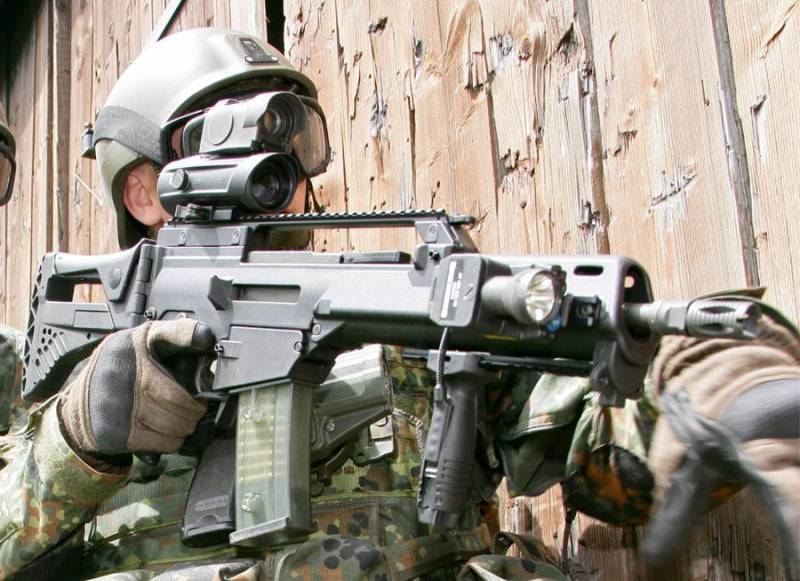

Time-tested, but not perfect.
Modernized under the IdZ program, the G36 submachine gun has largely lost its ergonomics. The same can be said about the new AK variants. For their time, both of these systems were ideal. They still retain their dignity. But their original architecture provides only limited opportunities for adaptation to new conditions. The main disadvantage is the difficult installation of optics.
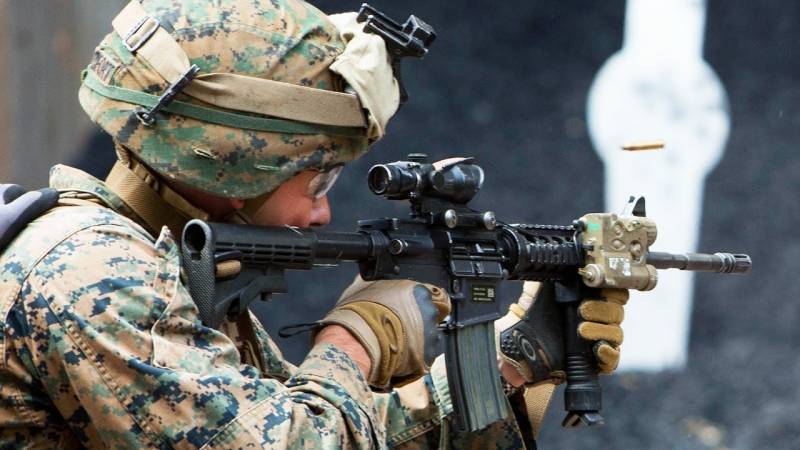
The AR-15 system has revolutionized gunsmithing. Despite all its shortcomings, AR is the best base for creating a modern machine.
It is impossible to consider in detail all the available samples of automata, and this is not necessary. Therefore, we will focus on the advantages and disadvantages of three: AK, AR and G36.
The strengths of AR are excellent ergonomics, modularity and high accuracy. AR is great for mounting optics, which largely determined its long life. In addition, it is more compact than competitors, which also makes AR more user-friendly.
However, AR has some technical solutions that seemed controversial even 60 years ago. These include a large number of small parts, as well as an excessive number of controls. First of all, this is the T-shaped reloading handle and the cartridge rammer located right in front of the arrow’s face, which is stationary when firing. The handle does not allow you to pull the shutter in the state of application, which is necessary when eliminating the delay. The rammer - attached in the process of refinement, and even the left part - serves to forcefully close the shutter of heavily contaminated weapons, and if the situation requires, then to silently close it.
The aforementioned reload handle and rammer can be called reference examples of “how not to do it”. In addition, the return spring located in the buttstock does not allow the buttstock to be folded, which complicates the life of soldiers moving on vehicles (and in our time this applies to almost everyone).
It is impossible not to mention the AR gas exhaust system, in which powder gases enter directly into the receiver. Many modern AR clones have replaced this with a more reliable short stroke gas piston system. It is also better suited for the use of tactical silencers.
Almost all modern AR models have a free-floating barrel, while the forearm is rigidly fixed to the receiver, and it can only be removed with a special tool. This makes cleaning difficult. In addition, the need to remove and reinstall the forend affects the point of impact, since it is equipped with a front sight and, possibly, a laser designator.
In contrast to AR, Kalashnikov assault rifles have fewer parts and are much easier to disassemble. A removable cover greatly facilitates the cleaning of the inside of the receiver from the remnants of gunpowder. The number of controls is minimal, and they are made quite large, which helps a lot in a state of stress.
However, in AK the idea of simplification is taken to the extreme. There are no two-way controls here, to disable the safety you need to remove your hand from the handle, which slows down this process. Attaching a store is also not very convenient and takes too much time.
In general, the AK architecture can be considered outdated. There is no question of any modularity. Of course, adaptability can also be taken to extremes and the machine can be weighted "everything-everything". Nevertheless, the ability to install the necessary additional equipment increases the combat capabilities of a soldier. The installation of optical and optoelectronic sights on the AK is possible only on the side bar, which is not very convenient. The installation of laser designators on the forearm is also out of the question.
Now there are various tuning kits, including a handguard with seats, covers with Picatinny rails, but all this makes the machine bulky and upsets the balance. Therefore, this can be considered only a temporary solution for poor African or former socialist countries.
The G36 concept is an interesting attempt to find a middle way. This is a modern, one might even say, futuristic weapon that combines the best elements of AK and AR and many original solutions. The result is perhaps the most convenient weapon of all. The short stroke gas engine and butterfly valve are extremely simple. For disassembly, you only need to pull out three pins. All parts are large, grippy and durable. Despite the fact that everything that is possible and impossible is made of plastic, the rifle is very durable. It is pleasant to hold it in your hands, even in the heat, even in the cold.
The universal rule for the execution of controls is only what is necessary and nothing more. G36 fully meets these requirements. Controls are accessible for both hands, conveniently located, grippy. The shutter release button is located in the trigger guard. The magazine latch is made similarly to AK. The fuse, on the contrary, resembles that of the AR. It is two-way, three-position: on, single fire, automatic fire. The angle between the extreme positions is 90 degrees.
The cocking handle can be bent both to the right and to the left, which makes it equally accessible for both right-handers and left-handers. In addition, it can be fixed in a bent position to be used as a rammer.
The main drawback of the G36 is the limited possibility of modernization. The stock with a cocking handle located on top of the receiver makes it difficult to install optics. Installing laser designators on the forend is also unreliable. Modernization attempts under the Infantry of the Future (IdZ) program look like a handicraft, turning a light and compact machine gun into a clumsy bandura.
Ideal Infantry Weapon
What should a good infantry rifle be capable of?
First of all, its accuracy should ensure the defeat of a growth target at a distance of 500 meters, including automatic fire. Its ammunition must have sufficient power and at the same time ensure the controllability of weapons when firing bursts. Depending on the concept of application - Battle rifle or machine gun - preference is given in the first case to power, in the second - to controllability.
The best basis for creating the “ideal infantry weapon” is the AR-15 platform, but with some changes.
A necessary attribute of modern weapons is a silencer or closed-type DTK - it improves weapon control, makes it difficult for the enemy to detect the shooter, does not harm the hearing organs of others, and also facilitates communication in battle.
The most important quality of weapons is reliability and resistance to pollution and harsh environmental conditions.
Resistance to pollution is provided by three factors. First, it is necessary to prevent the penetration of dirt, dust and moisture into the weapon. But sooner or later it will still be clogged with external dirt and combustion products of gunpowder. For reliable operation of automation in these conditions, the contact area of \uXNUMXb\uXNUMXbthe shutter with the receiver should be minimal. This can be achieved by making grooves on the bolt carrier. A gas regulator helps in such cases, increasing the volume of gases entering the gas engine.
Undoubtedly, the simplest, most reliable and easy to maintain is the gas exhaust system with a long piston stroke, where the piston is a single part with the bolt carrier. The most famous example where this system is used is AK.
A folding stock must be mandatory, so placing a return spring in it is undesirable. Adjustment of the butt in length and height is not required. The author's personal experience suggests that soldiers almost never use these opportunities.
The best material for making the upper part of the receiver - the upper receiver (upper receiver) - is aluminum. Steel is too heavy and plastic - G36 experience has shown that this is not the best choice.
The lower part of the receiver - the lower receiver (lower receiver) - can be fearlessly made of plastic. The fact that the metal upper and plastic lower parts of the receiver are well combined was proved by the What Would Stoner Do project of the InRangeTV channel. This is also evidenced by the quarter-century experience of military operation of the G36. Even with small, but highly loaded parts, such as a folding butt mechanism or some USM parts, there were no problems. In addition, plastic is lighter and cheaper. And holding plastic in the cold is more comfortable than metal.
For reliable installation of mechanical and optical sights, laser designators on Picatinny rails and M-LOK standard seats, the upper receiver and the upper part of the forearm must be a single part. At the same time, it should be possible to quickly install and remove the barrel. Examples of this design are the SIG MCX, Zastava MSC M19 and Beretta PMX. The Picatinny rail on top of the upper receiver and the M-LOK seats at 3 and 9 o'clock seem to be sufficient for attaching critical devices such as sights.
At the same time, elements such as a bipod or a front handle can be attached to the lower, removable part of the forearm. Easy access to the internal mechanisms of the weapon for cleaning and maintenance should be provided by a quick-detachable lower receiver connected to the upper only by pins.
We have already talked about the problem of the cocking lever on the AR platform. For this part, you need to choose a more convenient place. It must be accessible to both hands of the shooter and, if necessary, perform the task of the rammer. There are several options. One of them is a right-to-left shiftable handle that moves when fired, like on the BT APC223 or FN SCAR. This is a simple and reliable solution. However, American soldiers using the FN SCAR complain that the handle mounted on the left, when moving backward, injures the left hand of the right-handed shooter, while the handle on the right is dangerous for the left-hander. In addition, the handle is set too high, and when cocked, the shooter touches the optics mounted on the weapon with his hand.
A more complex solution, which, however, does not have the above disadvantages, is a handle that is stationary when firing, as on the NK433.
A combination of both options is also possible - a fixed handle on the left and rigidly connected to the bolt frame on the right. This seems like a good solution. It does not require rearrangement of the handle for right- and left-handed shooters.
The best solution for a magazine lock is a magazine latch located between the trigger guard and the magazine receiver, as on the AK and G36. It's secure, XNUMX-handed, and doesn't have the quirks of a two-way button like the AR. American soldiers also criticized the FN SCAR for the fact that there were cases of involuntary loss of the magazine, when, when carrying weapons on the chest, the magazine button touched, for example, some piece of equipment placed on the chest.
By analogy with the magazine latch, the placement of the slide delay from below suggests itself, as on the G36 or NK433. Thus, involuntary impact on it is excluded and accessibility for both hands is ensured.
We have already mentioned the convenience of using weapons in cramped conditions. This is provided by a folding stock.
Weight loss is also important. A good example of how this can be achieved is provided by Ian McCollum and Carl Casarda with the WWSD2020 rifle. It is very strong and reliable and weighs only 2 kg. Of course, our “ideal assault rifle” cannot be so light, if only because of the semi-monolithic upper receiver, but still fit into 3 kilograms (without cartridges and body kit) for a 5,56x45 caliber assault rifle and 3,5 kg for a Battle rifle seems possible.
The length of the barrel should correspond to the ammunition used and ensure the maximum disclosure of its potential. The barrel must not be shorter than 14 inches, otherwise the effective range will drop too much. The optimal size is 16 inches. 18 inches seems like overkill, given the possible use of a tactical silencer. For Battle rifles, 16 inches is the lower limit.
Mandatory is the presence of a mechanical sight as an auxiliary. Which optical sights to prefer depends on the task at hand. Non-enlarging sights, such as collimators, ensure reliable hitting of a growth target at a distance of 200-300 meters. At longer distances, magnifying sights are more effective. In close combat, the increase interferes.
Practice shows that the infantry mainly fights in cities, in the forest, on very rugged terrain. Shooting distances do not exceed 300 meters. This means that the speed of target acquisition is more important. And in this case, the optimal combination of a collimator sight with a folding magnifying nozzle, which allows you to fire at long distances.
A backup mechanical sight allows you to check the aiming point after, for example, the weapon has been dropped.
However, there are scenarios where the clashes occur at long distances, as was the case in Afghanistan. Here priority should be given to accurate long-range shooting. The best choice in this case is a variable power optical sight, such as the Trijicon VCOG 1-8x28, adopted by the US Marine Corps, or the Bundeswehr's ELCAN Specter 1x/4x. But even in this case it is impossible to refuse an additional collimator. At distances up to 100 meters, it is unrivaled and harmonizes well with night vision goggles.
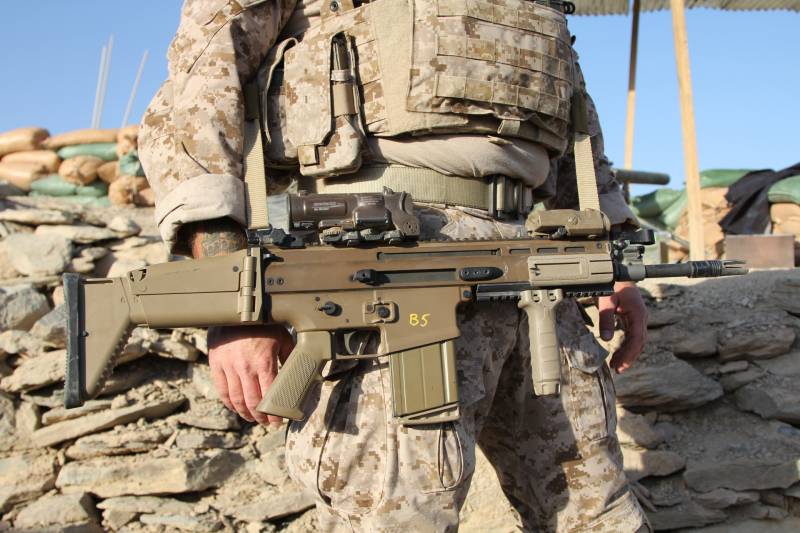
FN SCAR-H rifle with one of the best "automatic" sights Elcan Specter DR 1x/4x. Currently, this sight is accepted for the supply of the Bundeswehr
Riflescope Trijicon VCOG
Interesting developments of optical sights with rangefinders and ballistic computers. But this is more likely a solution for infantry snipers, and not for ordinary shooters.
Electron-optical sighting systems such as the Elbit ARCAS (Assault RifleCombat Application System) or the BAE System FWS-1, which is undergoing military trials in the US Army, can revolutionize night combat.
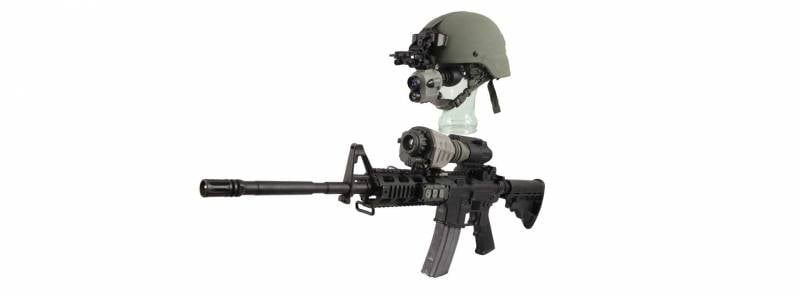
Devices for combat at night Elbit ARCAS and BAE System FWS-1
There are many options for all occasions.
Things like light and laser designators are very useful in urban combat, but using them against an enemy equipped with night vision (such as the Russian army) is dangerous, as they give away the location of the shooter. The same danger is represented by the glare of optics. They need to be dealt with with killFLASH anti-glare attachments.
Conclusions
Hand-held small arms do not currently decide the outcome of wars, but nevertheless, its role cannot be overestimated. This is a constant companion and the last chance for soldiers fighting directly on the front lines. Therefore, those responsible for the supply of the armed forces and the military industry are obliged to provide the fighters with a reliable and well-designed tool.
Currently, two families of small arms dominate the world: AK and AR, and therefore this class of weapons should develop along the path of their modernization and combining the successful solutions of these two systems.
- Franz Keck, Translation: Slug_BDMP
- Photos from open sources
Information